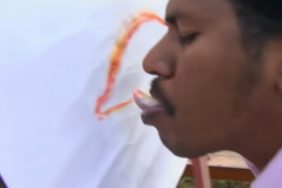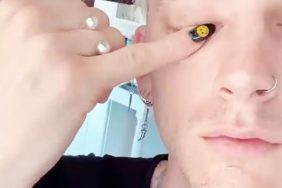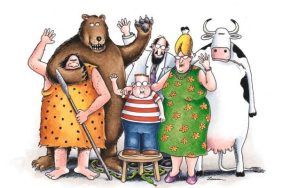Artwork: “Phone Repair” by Ronan Lynam.
Surgeons repairing a broken phone screen. An army of Oompa Loompas, all bearing Donald Trump’s face. The Teletubbies beating a man. A child urinating the image of the Mona Lisa onto fresh snow. These are just a few of the vibrant yet menacing creations of Ronan Lynam, an artist whose work emits both delightful and doom-filled vibes, like a cartoon that wandered astray and fell into the dark side.
Not that he sees his artwork in that light. The sense of something sinister underway doesn’t resonate for Lynam. “It’s something I really don’t understand–let alone intend,” he says. He considers his depictions, inundated with pop culture references and societal reflections, to be fun and colorful.

Artwork: “Tubby Buddy Breakdown” by Ronan Lynam.
Perhaps the subject matter is what’s grim, especially on the periodical covers he’s been commissioned for: a portrait of a drug dealer in an orange jumper for the Cleveland Scene or a chilling illustration of a little boy, one hand linked with his mother’s, another reaching for his little sister’s shadow in a story about a missing persons police unit for the Detroit Metro Times.
Animals are also omnipresent in the artist’s work: a spectacled dog in a business suit with a drool-soaked branch between his fangs in “Branch Manager” or four unsuspecting cats packed into a receptacle, about to be launched, in “Kitty Cannon”. But don’t go looking for a profound or subversive reason behind the beastly imagery. As Lynam says, “Animals are funny! You can put them in place of humans and many different situations and it adds an extra layer of silly to it. Plus, drawing people can sometimes just be a drag.”
Also: See The First Museum Exhibition of Stanley Kubrick’s Work
The artist, who graduated with a BFA from the University of Michigan’s Stamps School of A&D in 2013, was initially drawn to digital painting after seeing what people with drawing tablets were doing with Photoshop. He bought his own tablet and started teaching himself to use it. “That stuff really got my rocks off,” he says. “It’s a bit easier to get into a creative flow with digital painting, because the techniques used allow you to more organically create your goodies.”

Artwork: “The Mona Lisa” by Ronan Lynam.
Lynam was also interested in graphic illustration, a form that is simpler in detail and rendering, is more conceptually focused, and communicates ideas clearly. It also lends itself to T-shirt designs. For a long time, Lynam saw digital painting and graphic illustration as separate entities and was indecisive about which one would define his work. Then realized he didn’t have to choose; he could incorporate both.
Among his creative influences he names Sam Spratt, an illustrator who cut his teeth at Gawker, and with whose digital painting Lynam became “obsessed”. He has also taken cues from graphic artists like Glennz and Aled Lewis, both of whom use humor and cleverness to make their work stand out. The former employs iconic characters like Pinocchio, the Gingerbread Man, and Winnie the Pooh, inserting them into humiliating, and often deranged, scenarios; the latter has a series that imagines what animals would say if they could talk (mostly witty one-liners).
“I really enjoy making work that’s got some spicy humor in it. Pop culture is just begging to be shaped and twisted,” Lynam says.
Even when an idea has been done to death, he says, one’s personal touch could take it in a new direction. “I sometimes see people expressing how pop culture inspired work can often be considered a low-hanging fruit. Maybe that’s because it’s ‘too easy’, such as picking on Trump. I don’t think that gives it enough credit. To me, the fascinating thing about make pop-inspired work is figuring out the twist you can bring to it. It’s sometimes like solving a puzzle: you just know there’s a missing piece to it that would make it great, so you need to brainstorm a bunch of different directions you could take it. It’s an exhilarating feeling when you finally have that ‘A-ha!’ moment and everything just clicks!”

Artwork: “Troompa Loompa” by Ronan Lynam.
Lynam, who grew up in West Michigan and now lives in Grand Rapids, works from his apartment, taking breaks to walk around the medium-sized city. “I wouldn’t describe it necessarily as having a direct influence on my work rather than a positive influence on my life,” he says of his current home base. “It’s hard to make stuff when you’re miserable.” These outdoor excursions also serve as the backdrop for his social media marketing; he often photographs prints of his work in nature, lending an extra layer of artistry to his Instagram. On his Tumblr feed, the art displayed shimmers and shakes in such a subtle way, it feels like an eerie optical illusion.
A full-time freelancer, Lynam aspires to do more editorial illustration work. The process is fairly hands-off, allowing him to start drawing for stories with just a few sentences from a writer’s draft. The turnaround time on those commissions can be quick, however. “I do always, always appreciate more time to work on things. Even though I may complete work quickly sometimes, it’s extremely helpful to put things on the back-burner for a while,” he says. “Revisiting it days later is an absolutely excellent way to see things you couldn’t see before. I think this applies to a lot of big decisions in life as one of the surest ways to gain a new perspective is simply by giving it time.”
Time is one thing he has plenty of. Only 25, Lynam appears to have a long, promising career ahead of him. Ultimately, he hopes that his creations will incite an appetite in art-lovers to see more of his work. And, he adds, “It sounds cliché, but I want to make people smile!” Cliché? Nah. More like charming. One would expect nothing less than hopeful optimism from an artist so young.






